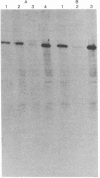Abstract
The S region of the murine major histocompatibility complex controls the expression of two related, serum substance-positive proteins; one (C4) has functional complement activity, whereas the other, the sex-limited protein (Slp), is hemolytically nonfunctional. The structural relationships of these molecules to each other and to their putative intracellular precursors have been examined. Radiolabeled intracellular C4 and Slp precursors were isolated from lysates of cultured peritoneal cells. The C4 and Slp precursors and their processed subunits were purified by immunoprecipitation and sodium dodecyl sulfate/polyacrylamide gel electrophoresis. Antigenically distinct precursors for C4 and Slp were demonstrated by sequential immunoprecipitation experiments in which anti-Slp-reactive molecules were precleared by exhaustive immunoprecipitation and residual C4 molecules were precipitated by antibody to serum substance. Both molecules had apparent molecular weights of 185,000. Their molecular identities as precursors of the mature C4 and Slp proteins were established in pulse-chase studies and by comparisons of their tryptic peptide profiles with those of isolated subunits from the processed proteins. When isolated α- or β-subunits from C4 and Slp proteins were compared by peptide mapping, it was possible to detect multiple distinct and multiple shared peptides. This evidence indicates that the C4 and Slp proteins derive from distinct precursor polypeptides and suggests that the primary structures of the C4 and Slp α- and β-subunits are different. These results support the postulate that the S region contains two discrete structural loci that specify discrete C4 and Slp proteins.
Keywords: major histocompatibility complex, gene duplication
Full text
PDF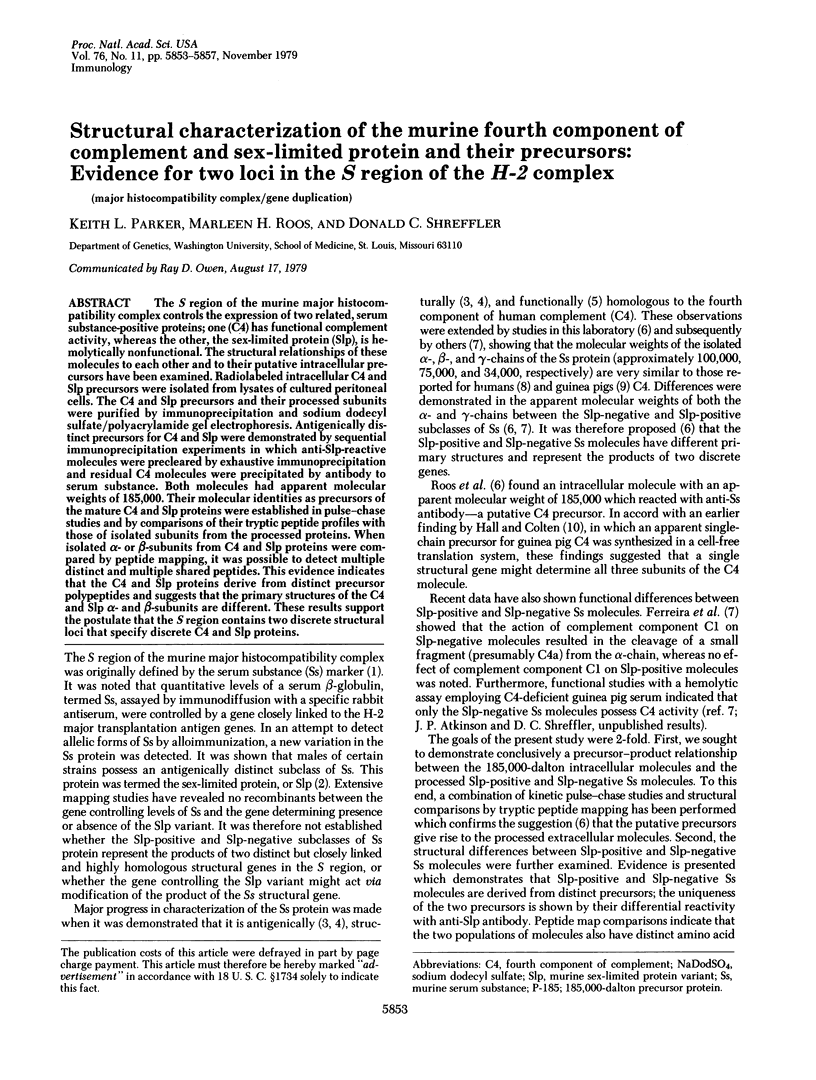
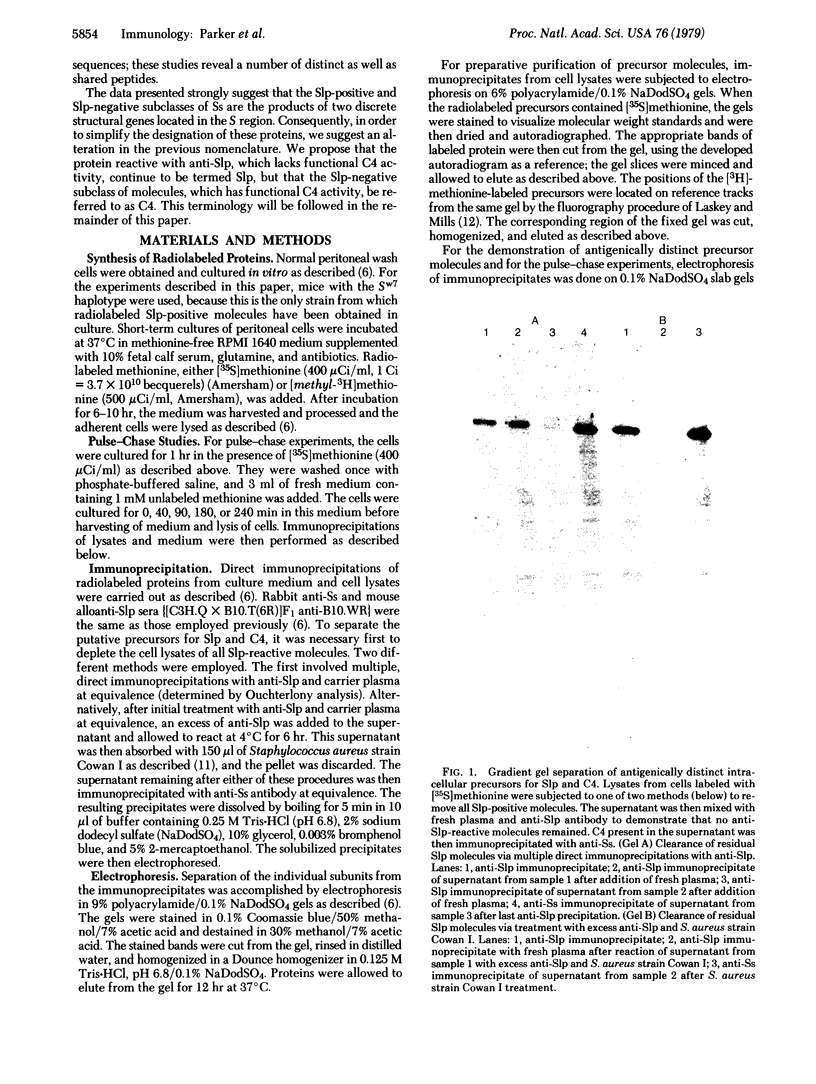
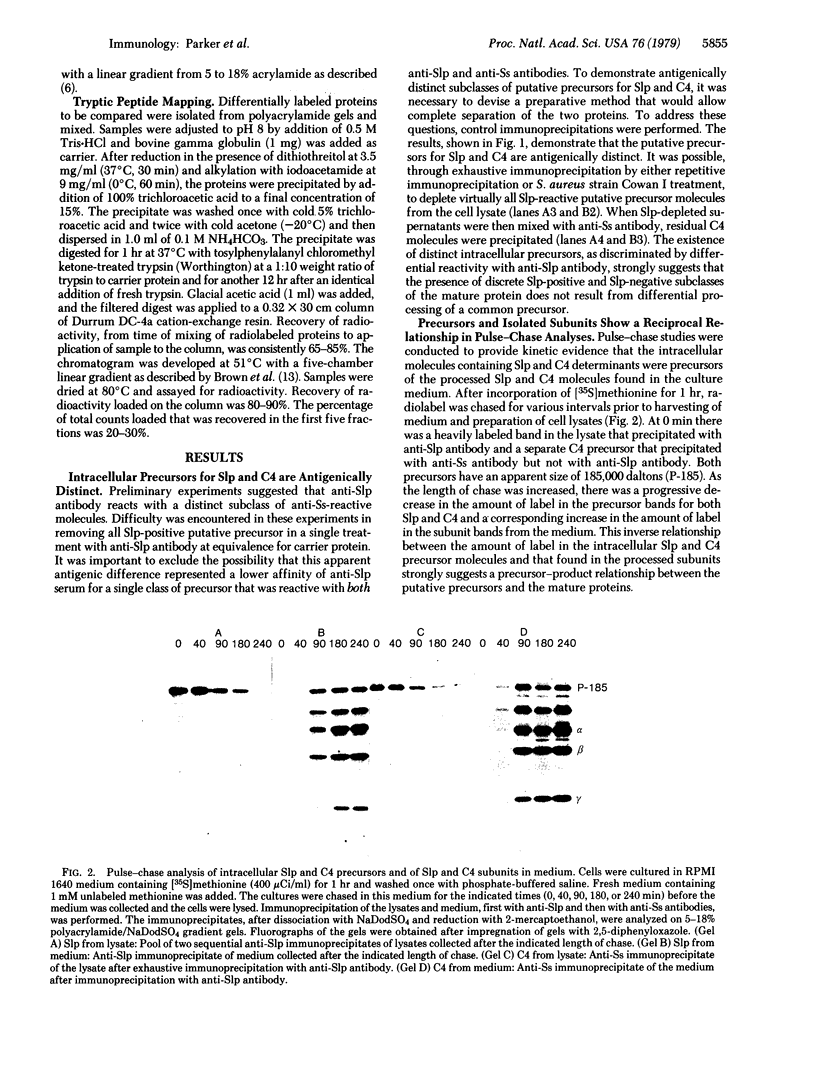
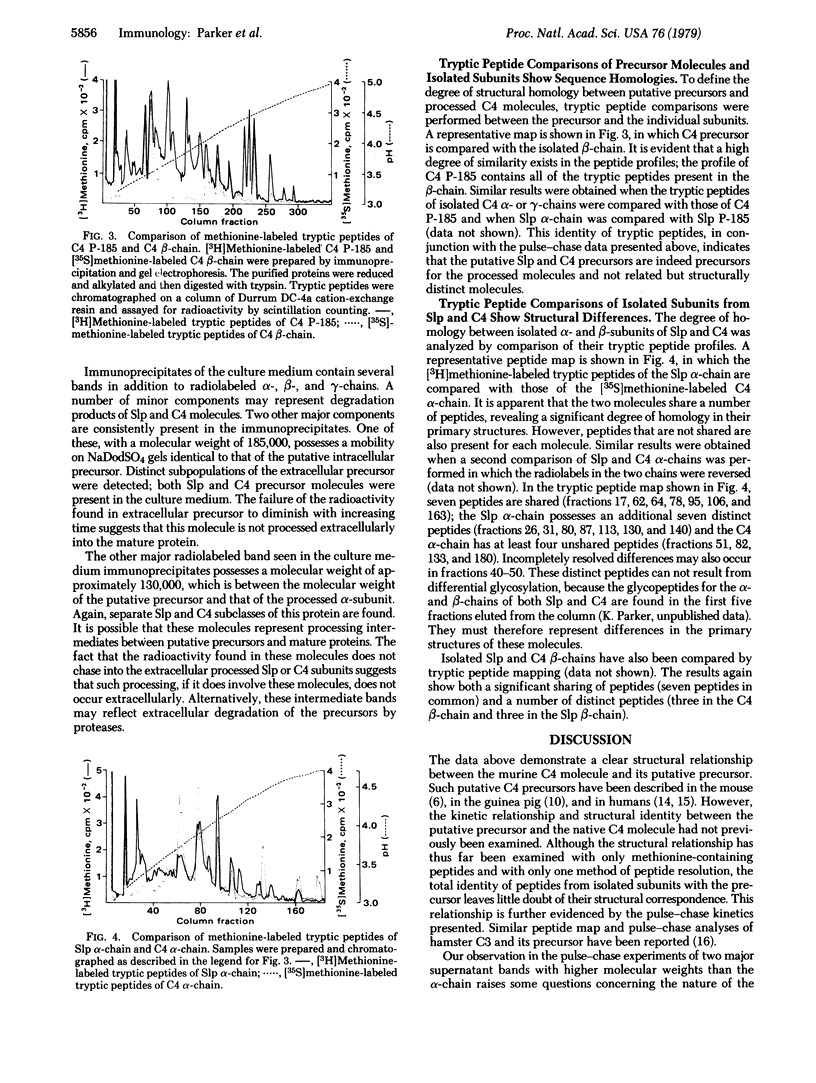
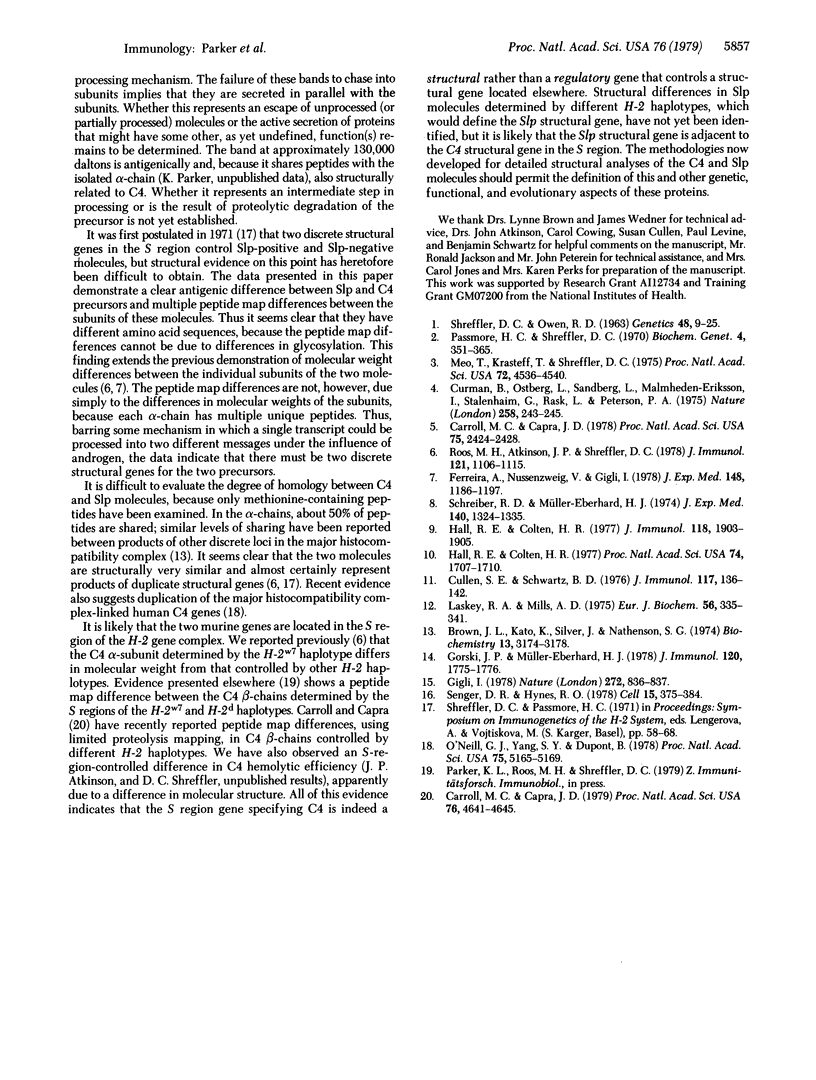
Images in this article
Selected References
These references are in PubMed. This may not be the complete list of references from this article.
- Brown J. L., Kato K., Silver J., Nathenson S. G. Notable diversity in peptide composition of murine H-2K and H-2D alloantigens. Biochemistry. 1974 Jul 16;13(15):3174–3178. doi: 10.1021/bi00712a027. [DOI] [PubMed] [Google Scholar]
- Carroll M. C., Capra J. D. Studies on murine Ss protein: demonstration that S region encodes structural gene for fourth component of complement. Proc Natl Acad Sci U S A. 1979 Sep;76(9):4641–4645. doi: 10.1073/pnas.76.9.4641. [DOI] [PMC free article] [PubMed] [Google Scholar]
- Carroll M. C., Capra J. D. Studies on the murine Ss protein: demonstration that the Ss protein is functionally the fourth component of complement. Proc Natl Acad Sci U S A. 1978 May;75(5):2424–2428. doi: 10.1073/pnas.75.5.2424. [DOI] [PMC free article] [PubMed] [Google Scholar]
- Cullen S. E., Schwartz B. D. An improved method for isolation of H-2 and Ia alloantigens with immunoprecipitation induced by protein A-bearing staphylococci. J Immunol. 1976 Jul;117(1):136–142. [PubMed] [Google Scholar]
- Curman B., Ostberg L., Sandberg L., Malmheden-Eriksson I., Stålenheim G., Rask L., Peterson P. A. H-2 linked Ss protein is C4 component of complement. Nature. 1975 Nov 20;258(5532):243–245. doi: 10.1038/258243a0. [DOI] [PubMed] [Google Scholar]
- Ferreira A., Nussenzweig V., Gigli I. Structural and functional differences between the H-2 controlled Ss and Slp proteins. J Exp Med. 1978 Nov 1;148(5):1186–1197. doi: 10.1084/jem.148.5.1186. [DOI] [PMC free article] [PubMed] [Google Scholar]
- Gigli I. A single chain precursor of C4 in human serum. Nature. 1978 Apr 27;272(5656):836–837. doi: 10.1038/272836a0. [DOI] [PubMed] [Google Scholar]
- Hall R. E., Colten H. R. Cell-free synthesis of the fourth component of guinea pig complement (C4): identification of a precursor of serum C4 (pro-C4). Proc Natl Acad Sci U S A. 1977 Apr;74(4):1707–1710. doi: 10.1073/pnas.74.4.1707. [DOI] [PMC free article] [PubMed] [Google Scholar]
- Hall R. E., Colten H. R. Molecular size and subunit structure of the fourth component of guinea pig complement. J Immunol. 1977 May;118(5):1903–1905. [PubMed] [Google Scholar]
- Laskey R. A., Mills A. D. Quantitative film detection of 3H and 14C in polyacrylamide gels by fluorography. Eur J Biochem. 1975 Aug 15;56(2):335–341. doi: 10.1111/j.1432-1033.1975.tb02238.x. [DOI] [PubMed] [Google Scholar]
- Meo T., Krasteff T., Shreffler D. C. Immunochemical characterization of murine H-2 controlled Ss (serum substance) protein through identification of its human homologue as the fourth component of complement. Proc Natl Acad Sci U S A. 1975 Nov;72(11):4536–4540. doi: 10.1073/pnas.72.11.4536. [DOI] [PMC free article] [PubMed] [Google Scholar]
- O'Neill G. J., Yang S. Y., Dupont B. Two HLA-linked loci controlling the fourth component of human complement. Proc Natl Acad Sci U S A. 1978 Oct;75(10):5165–5169. doi: 10.1073/pnas.75.10.5165. [DOI] [PMC free article] [PubMed] [Google Scholar]
- Passmore H. C., Shreffler D. C. A sex-limited serum protein variant in the mouse: inheritance and association with the H-2 region. Biochem Genet. 1970 Jun;4(3):351–365. doi: 10.1007/BF00485752. [DOI] [PubMed] [Google Scholar]
- Roos M. H., Atkinson J. P., Shreffler D. C. Molecular characterization of the Ss and Slp (C4) proteins of the mouse H-2 complex: subunit composition, chain size polymorphism, and an intracellular (PRO-Ss) precursor. J Immunol. 1978 Sep;121(3):1106–1115. [PubMed] [Google Scholar]
- Schreiber R. D., Müller-Eberhard H. J. Fourth component of human complement: description of a three polypeptide chain structure. J Exp Med. 1974 Nov 1;140(5):1324–1335. doi: 10.1084/jem.140.5.1324. [DOI] [PMC free article] [PubMed] [Google Scholar]
- Senger D. R., Hynes R. O. C3 component of complement secreted by established cell lines. Cell. 1978 Oct;15(2):375–384. doi: 10.1016/0092-8674(78)90006-5. [DOI] [PubMed] [Google Scholar]
- Shreffler D C, Owen R D. A Serologically Detected Variant in Mouse Serum: Inheritance and Association with the Histocompatibility-2 Locus. Genetics. 1963 Jan;48(1):9–25. doi: 10.1093/genetics/48.1.9. [DOI] [PMC free article] [PubMed] [Google Scholar]



